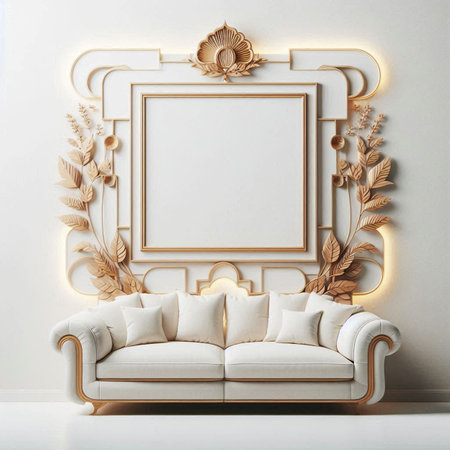1. Understanding Feng Shui Principles for Art Selection
When it comes to choosing art and decorations for your living room, Feng Shui offers practical and meaningful guidelines that can help create a harmonious, welcoming environment. Even if you’re new to Feng Shui or live in the United States, these core principles are easy to follow and can make a noticeable difference in how your space feels.
The Basics of Feng Shui in the Living Room
Feng Shui is all about balancing energy (known as “Chi”) in your home. The living room is a central gathering place, so it’s important that the art and decorations here promote positivity, comfort, and flow. To achieve this, consider the following key elements:
Color Choices
Colors play a huge role in Feng Shui because each color represents a different type of energy. Here’s how you might apply this to an American living room:
| Color | Feng Shui Meaning | Best For |
|---|---|---|
| Blue & Green | Calmness, growth, renewal | Promoting relaxation and fresh energy |
| Yellow & Earth Tones | Warmth, stability, grounding | Creating a cozy and inviting atmosphere |
| Red & Orange | Passion, excitement, vibrancy | Adds energy but best used as accents |
| White & Light Gray | Clarity, openness, purity | Makes rooms feel more spacious and bright |
Symbolism in Art and Decor
The images and symbols you display have an impact on the room’s mood. In American homes, popular choices like landscapes, family portraits, or abstract art can all be chosen with intention:
- Nature scenes: Images of water, mountains, or forests bring calm and abundance.
- Happy gatherings: Artwork depicting joyful people or animals can encourage positive relationships.
- Avoid negative imagery: Steer clear of art that feels sad or chaotic—it can influence the mood of the entire space.
Energy Flow (Chi)
The way you arrange your art and decorations affects how energy moves through your living room. For optimal Chi flow:
- Hang artwork at eye level to keep energy balanced and comfortable.
- Avoid clutter—too many decorations can block positive energy.
- Create focal points with larger pieces above the sofa or fireplace to guide attention naturally through the space.
Quick Tips for Americans New to Feng Shui Art Selection:
- Select colors based on the mood you want: cool for calm, warm for connection.
- Choose uplifting images that reflect your values and culture.
- Edit your collection seasonally to keep the energy fresh.
This foundation will help you begin selecting art and décor that brings good Feng Shui into your living room, blending ancient wisdom with your personal American style.
2. Selecting Art That Promotes Positive Energy
When choosing art for your living room, its important to select pieces that uplift the space and encourage good Feng Shui. In American homes, artwork is often used to express personality, inspire positivity, and create a welcoming atmosphere. Here’s how you can make thoughtful choices:
Choose Uplifting Themes
Select art that reflects happiness, hope, or inspiration. Images of families, friends, celebrations, or scenes that evoke fond memories can help set a joyful tone in your living room. Avoid artwork that looks sad, lonely, or depicts conflict, as these can lower the energy in the space.
Embrace Nature and Harmonious Imagery
Nature-themed art is a popular choice in both Feng Shui and American decor. Pictures of forests, mountains, rivers, flowers, or peaceful landscapes bring a sense of calm and natural balance into your home. These images can help create a relaxing environment where everyone feels comfortable.
Examples of Positive vs. Negative Artwork
| Positive (Recommended) | Negative (Avoid) |
|---|---|
| Sunrises & Sunsets | Storms & Destruction |
| Blooming Flowers | Withered Plants |
| Peaceful Animals (birds, horses) | Aggressive Animals (snakes, predators) |
| Lush Landscapes | Barren Deserts |
| Smiling Faces or Happy Families | Crying Faces or Solitude |
Avoid Aggressive or Negative Motifs
Artwork with harsh lines, dark colors, or aggressive imagery—like wild predators or chaotic abstract designs—can disrupt the positive flow of energy in your living room. Instead, opt for gentle shapes and soothing color palettes that help everyone feel at ease.

3. Incorporating Family Photos and Personal Memories
Personal touches like family photos and treasured keepsakes can make your living room feel warm and inviting. In Feng Shui, how you display these items matters just as much as what you choose to show. When done right, they help build positive energy (Qi) and strengthen the sense of connection in your home.
Choosing the Right Photos and Mementos
Select images and objects that bring back happy memories and reflect harmony within your family. Avoid displaying photos from stressful events or featuring people you no longer have a good relationship with, as these can introduce unwanted energy.
Placement Tips for Good Feng Shui
| Area in Living Room | What to Display | Feng Shui Reason |
|---|---|---|
| East Wall | Family portraits, group photos | Supports family health and unity |
| Southwest Corner | Couple photos, marriage mementos | Enhances love and relationships |
| Near Entryway (but not directly facing the door) | Friendly gatherings, joyful moments | Welcomes positive energy into your home |
| Main Sitting Area | Photos of shared experiences, vacations | Promotes conversation and togetherness |
How to Arrange Your Displays
- Avoid Clutter: Too many frames or trinkets can disrupt energy flow. Leave space between each item.
- Use Quality Frames: Choose frames in earth tones or soft colors that blend well with your decor for a calm effect.
- Height Matters: Hang photos at eye level so everyone can enjoy them easily.
- No Broken Items: Don’t display cracked frames or damaged mementos; they can symbolize broken relationships.
- Circular Arrangements: Grouping items in circular patterns encourages harmony and inclusiveness.
A Few American-Style Ideas to Try:
- Create a gallery wall with family milestones—graduations, weddings, vacations—to celebrate life’s highlights.
- Add personal touches like a framed ticket from a favorite concert or a postcard from a road trip across the States.
- Mix photos with art pieces or inspirational quotes that reflect your family’s values for added positivity.
The key is to make your living room feel both personal and harmonious, ensuring that every photo or keepsake you choose helps foster warmth, connection, and good vibes according to Feng Shui principles.
4. Choosing Decorations and Accents for Balance
When it comes to decorating your living room for good Feng Shui, the right accents can make all the difference. In American homes, throw pillows, vases, and sculptures are popular choices that can also fit well with traditional Feng Shui principles. The goal is to create a sense of balance, harmony, and positive energy—what Feng Shui calls “Chi.” Here’s how you can choose decorative items that blend both American style and Feng Shui wisdom:
Understanding Balance in Feng Shui
Feng Shui emphasizes balance through the five elements: wood, fire, earth, metal, and water. Try to include decor items that represent these elements for a more harmonious space. At the same time, think about the colors and shapes that feel welcoming in an American living room.
Suggestions for Decorative Items
| Item Type | Feng Shui Element | American Style Example | Feng Shui Tip |
|---|---|---|---|
| Throw Pillows | Earth (yellows), Fire (reds), Water (blues) | Pillows with geometric or floral prints | Choose soft fabrics and avoid sharp patterns for a cozy feel. Mix warm and cool colors for balance. |
| Vases | Water (glass/blue), Metal (silver/white) | Ceramic or glass vases in trendy shapes | Display fresh flowers or bamboo for life energy. Keep vases clean and uncluttered. |
| Sculptures | Wood (carved objects), Metal (bronze/gold) | Abstract art pieces or animal figurines | Select gentle forms like curves or circles. Avoid sharp edges pointing toward seating areas. |
| Candles/Lamps | Fire (red/orange candles), Earth (clay lamp bases) | Mason jar candles or classic table lamps | Add soft lighting for warmth. Place lights in darker corners to energize the space. |
Placement Tips for Maximum Harmony
- Symmetry: Arrange pairs of similar items on both sides of the sofa to create visual harmony.
- Avoid Clutter: Too many decorations can block energy flow; keep surfaces neat.
- Personal Touches: Family photos or travel souvenirs are welcome if they spark happy memories—positive feelings help Chi flow!
- Nature Elements: Add houseplants for freshness and vitality. Just be sure they’re healthy and well-maintained.
- No Sharp Corners: Avoid placing items with pointed edges near where people sit or walk.
Blending Styles for a Unique Look
You don’t have to choose between modern American décor and classic Feng Shui. Mixing your favorite styles with these mindful touches creates a welcoming space that looks great and feels even better!
5. Placement Tips for Art and Decorations
When it comes to good Feng Shui in your living room, where and how you display art and decorations can make a big difference. Here are some practical tips tailored for American homes that will help you create harmony, comfort, and positive energy.
Choose the Right Wall
In many American homes, the living room often has one or two main walls that naturally draw attention—such as the wall behind the couch or above the fireplace mantel. These spots are ideal for displaying your favorite pieces. Make sure the artwork is not hung too high; eye level is best for most people, which means the center of the art should be about 57-60 inches from the floor.
Art Placement Table
| Location | Type of Art/Decor | Feng Shui Impact | Tips |
|---|---|---|---|
| Above Sofa | Large paintings, family photos | Creates a focal point, supports relationships | Choose calm, joyful images; ensure it’s securely mounted |
| Fireplace Mantel | Sculptures, small framed art, plants | Attracts positive energy upward | Avoid clutter; use odd numbers (like 3 or 5 items) for balance |
| Entry Wall (facing front door) | Mirrors, inspirational quotes | Welcomes energy; expands space visually | Avoid mirrors directly facing the door; reflect pleasant views instead |
| Corner Spaces | Tall plants, standing lamps, small sculptures | Lifts stagnant energy; fills dead zones | Avoid overcrowding corners; let energy flow around items |
Create Balance with Groupings
If you want to display multiple pieces of art or decor together (like a gallery wall), try to keep an even distance between frames and objects. Symmetrical arrangements create a sense of stability and peace. For a more dynamic look that still feels balanced, use a mix of sizes but keep similar colors or themes together.
Helpful Hanging Tips:
- Avoid placing art too high: This makes spaces feel disconnected.
- No sharp or aggressive images: Steer clear of stormy seascapes or harsh abstract lines right where you relax.
- Add softness: Frame art with soft-edged frames or surround with plants for a calming effect.
- Mood lighting: Highlight special art pieces with adjustable lighting to enhance their positive impact.
- Rotate seasonally: Switch up smaller decorations based on seasons or holidays to refresh the room’s energy.
Avoid Common Mistakes
- No clutter: Too many small items can make energy feel stuck—choose fewer but more meaningful pieces.
- Avoid negative symbolism: Skip images of isolation or sadness in social spaces like living rooms.
- No mirrors reflecting mess: If you use mirrors, ensure they reflect organized and beautiful parts of your home, not cluttered areas.
Quick Reference: Best Spots for Living Room Decor in US Homes
- Main wall behind sofa: Centerpiece artwork or statement mirror.
- Mantel: Balanced arrangement of decor with varying heights.
- Niches/corner shelves: One tall plant or sculpture per space.
- Coffee table: Low arrangement of books or flowers—keep it simple!
- Adjacent walls: Smaller paired artworks for added depth without overwhelming the room.


